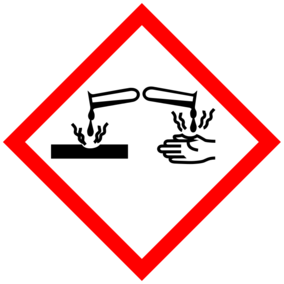Piranha solution
Piranha solution (also known as piranha etch or acid piranha) is a popular name for a solution of Caro's acid [1] which is usually prepared by reacting sulfuric acid and hydrogen peroxide; it is used to clean organic residues from glassware or other acid resistant materials.
Piranha base (or base piranha) is another form of piranha solution, that uses ammonium hydroxide (concentrated aqueous ammonia), instead of sulfuric acid, and hydrogen peroxide, in a 3:1 ratio. It is equally dangerous as acid piranha when hot, although the base piranha must be heated to 60°C before the reaction takes off.[2]
Contents
[hide]Properties
Piranha solution is a dense clear transparent liquid. A typical mixture is has a ratio of 3:1 (similar to aqua regia mixture) concentrated sulfuric acid to 30% hydrogen peroxide solution, however other known solutions have 4:1 or even 7:1 mixture.
Base piranha has similar properties.
Piranha solution are usually used to clean organic residues as well as graphite, mostly from silicon wafers in microelectronics.[3]
Piranha solution is very useful when cleaning fritted glassware. Since the size of the pores of sintered glassware is critical for its function, it should be avoided cleaning it with strong bases, which gradually dissolve the sinter. Sintered glass also tends to capture material deep within the structure, that it difficult to remove. Piranha solution can remove such organic residues, without damaging the sintered glass.
Piranha solution also has the interesting property of reducing potassium permanganate instantly on contact. This is interesting to watch as the deep purple color of manganese(VII) is reduced to the nearly colorless manganese(II).
Preparation
In an extremely clean graduated cylinder, add a predefined volume of concentrated sulfuric acid. Very slowly add 1/3rd volume (or 1/4th, 1/7th depending on the desired ratio) hydrogen peroxide. While it might appear wrong to add the peroxide (which contains water) into concentrated sulfuric acid, as it's well known that the sulfuric acid is the one that gets dissolved in water to prevent splashing, there is a serious risk of explosion if a mixture of H2O2-H2SO4 has more than 50% hydrogen peroxide. The mixing is highly exothermic, and the resultant heat can bring the temperature of the solution to over 100 °C. If the temperature increases suddenly, it can lead to violent boiling or even splashing. Explosions may occur if the concentration of the peroxide solution is higher than 50%.
Base piranha is prepared in the same way.
Hazards and safety tips
Piranha solution is extremely dangerous, as it is both strongly acidic and a strong oxidizer. Solutions no longer being used should never be left unattended if hot. Never store it in a closed container. Piranha solution must never be disposed with organic solvents (e.g. in waste organic solvents), as this will cause a violent reaction and explosion.
See also
References
- Jump up ↑ http://sciencemadness.wikia.com/wiki/Caro%27s_Acid
- Jump up ↑ http://www.ehss.vt.edu/programs/HCM_piranha.php
- Jump up ↑ www.physics.utah.edu/Phys5719/Vaporization/GlassCleaners.doc
